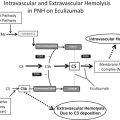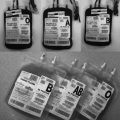Paroxysmal cold hemoglobinuria is a rare cause of autoimmune hemolytic anemia predominantly seen as an acute form in young children after viral illnesses and in a chronic form in some hematological malignancies and tertiary syphilis. It is a complement mediated intravascular hemolytic anemia associated with a biphasic antibody against the P antigen on red cells. The antibody attaches to red cells at colder temperatures and causes red cell lysis when blood recirculates to warmer parts of the body. Treatment is mainly supportive and with red cell transfusion, but immunosuppressive therapy may be effective in severe cases.
Key points
- •
Paroxysmal cold hemoglobinuria is a rare cause of autoimmune hemolytic anemia predominantly seen as an acute form in young children after viral illnesses and in a chronic form in some hematological malignancies and tertiary syphilis.
- •
Paroxysmal cold hemoglobinuria is a complement medicated intravascular hemolytic anemia associated with a biphasic antibody against the P antigen on red cells. The antibody attaches to red cells at colder temperatures and causes red cell lysis when blood recirculates to warmer parts of the body.
- •
Treatment for paroxysmal cold hemoglobinuria is mainly supportive and with red cell transfusion, but immunosuppressive therapy shows promise in severe cases.
Introduction
Of the types of autoimmune hemolytic anemias an adult hematologist will encounter, paroxysmal cold hemoglobinuria (PCH) is one of the rarest. PCH is a phenomenon seen not uncommonly in association with tertiary syphilis, and the advent of antibiotics has dramatically reduced the prevalence of this fascinating phenomenon in the developed world. A large majority of patients with PCH in the early twentith century had a chronic relapsing form of the disease in association with tertiary or congenital syphilis. Recurrent/relapsing episodes of intravascular hemolysis were precipitated by exposure of the body to cold temperatures, which improved on warming. In the modern era, when it is rare to find cases of advanced syphilis, PCH is seen mostly in young children, where it presents as acute hemolysis after a viral illness. It is usually nonrecurrent, with a male preponderance, and presents with a rapid onset syndrome with prompt recovery with rest, warmth, and blood transfusion support as needed.
The mechanism of hemolysis in PCH was elucidated by Julius Donath and Karl Landsteiner in 1904. They described a 2-phase process: the antibodies responsible for the red cell breakdown were initially adsorbed on the red cells below normal body temperatures. The affected red cells were then lysed when circulating blood was warmed to normal body temperature. This 2-step process, or the Donath-Landsteiner (DL) reaction, was one of the first laboratory tests invented in the investigation of autoimmune hemolytic anemias (AIHAs). The role of complement, and its essential part in the hemolytic reaction, was elucidated further in the early 1950s.
Introduction
Of the types of autoimmune hemolytic anemias an adult hematologist will encounter, paroxysmal cold hemoglobinuria (PCH) is one of the rarest. PCH is a phenomenon seen not uncommonly in association with tertiary syphilis, and the advent of antibiotics has dramatically reduced the prevalence of this fascinating phenomenon in the developed world. A large majority of patients with PCH in the early twentith century had a chronic relapsing form of the disease in association with tertiary or congenital syphilis. Recurrent/relapsing episodes of intravascular hemolysis were precipitated by exposure of the body to cold temperatures, which improved on warming. In the modern era, when it is rare to find cases of advanced syphilis, PCH is seen mostly in young children, where it presents as acute hemolysis after a viral illness. It is usually nonrecurrent, with a male preponderance, and presents with a rapid onset syndrome with prompt recovery with rest, warmth, and blood transfusion support as needed.
The mechanism of hemolysis in PCH was elucidated by Julius Donath and Karl Landsteiner in 1904. They described a 2-phase process: the antibodies responsible for the red cell breakdown were initially adsorbed on the red cells below normal body temperatures. The affected red cells were then lysed when circulating blood was warmed to normal body temperature. This 2-step process, or the Donath-Landsteiner (DL) reaction, was one of the first laboratory tests invented in the investigation of autoimmune hemolytic anemias (AIHAs). The role of complement, and its essential part in the hemolytic reaction, was elucidated further in the early 1950s.
Mechanism of hemolysis
PCH is a complement-mediated intravascular hemolytic process in which a polyclonal immunoglobulin G (IgG) autoantibody binds to the P antigen, a polysaccharide on the red cell surface of most humans. This polyclonal IgG is unusual in that it reacts at cold temperatures (unlike most IgG-mediated hemolytic anemias that react at warm temperatures). The antibody attaches to the red blood cell (RBC) membrane along with the first 2 components of complement at colder temperatures (such as the extremities in cold weather). When the red cells circulate to warmer parts of the body, intravascular hemolysis occurs by activation of the complement cascade.
PCH is differentiated from cold agglutinin disease because it does not involve IgM antibodies and lacks the classic blood smear findings of red cell agglutination.
Prevalence and clinical presentation
There are limited population-level data on the prevalence of PCH, but most cases in the current day are children who present with a postinfectious acute hemolytic episode, which will likely never recur. Most cases are seen in children before their fifth birthday, with a male predominance. In this age group, PCH was as common as warm autoimmune hemolytic anemia (AIHA) as the cause of hemolysis in the British study by Sokol and colleagues. This finding did not hold true in a more recent Italian study, which found PCH accounting for only 6% of total childhood cases of AIHA and with a male:female ratio of 5:1. Another study found the prevalence of PCH to be about 32% of childhood cases of AIHA, also noting the higher prevalence in boys. The prevalence of PCH is likely reflective of the sensitivity of the DL test, which can be increased by using papain enzyme-treated (as opposed to untreated) red cells to detect hemolysis.
Episodes of PCH in children are usually concurrent or appear after a viral or bacterial infection, including measles, mumps, cytomegalovirus, Epstein-Barr virus, varicella, influenza, mycoplasma, and Hemophilus influenzae . Hemolysis is usually transient and self-limiting, but severe cases can result in acute renal failure. The symptoms may include hemoglobinuria, rigors, chills, myalgias, nausea, fatigue, and jaundice. Other common symptoms are cough (likely from the viral infection), anorexia, headache, and loin and back pain. The physical examination findings of PCH are those of anemia and icterus; because it is predominantly an intravascular hemolytic process, patients do not usually present with significant splenomegaly or adenopathy (unless there is an underlying process such as lymphoma).
Congenital or tertiary syphilis was responsible for more than 90% of cases of PCH in the early 1900s, with a chronic relapsing form of the disease especially worse during the winter. After the advent of effective antibiotic therapy and epidemiologic measures like contact tracing and screening of pregnant women, congenital and tertiary syphilis became rare entities. Rarely, adults present with PCH after viral infections such as varicella. Other cases of PCH in adults have been reported in association with non-Hodgkin lymphoma and myeloproliferative disorders, although the etiologic connection is unknown.
Stay updated, free articles. Join our Telegram channel

Full access? Get Clinical Tree






